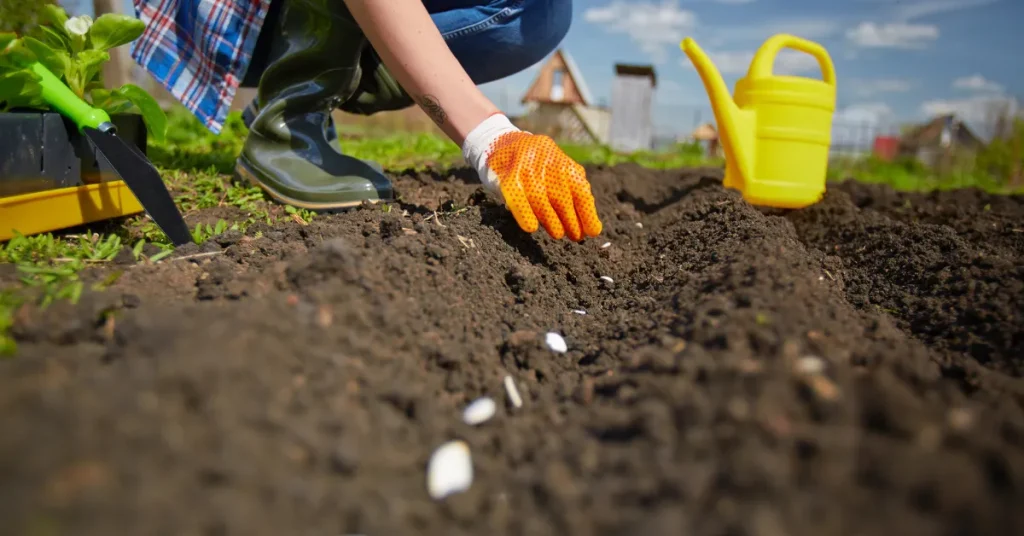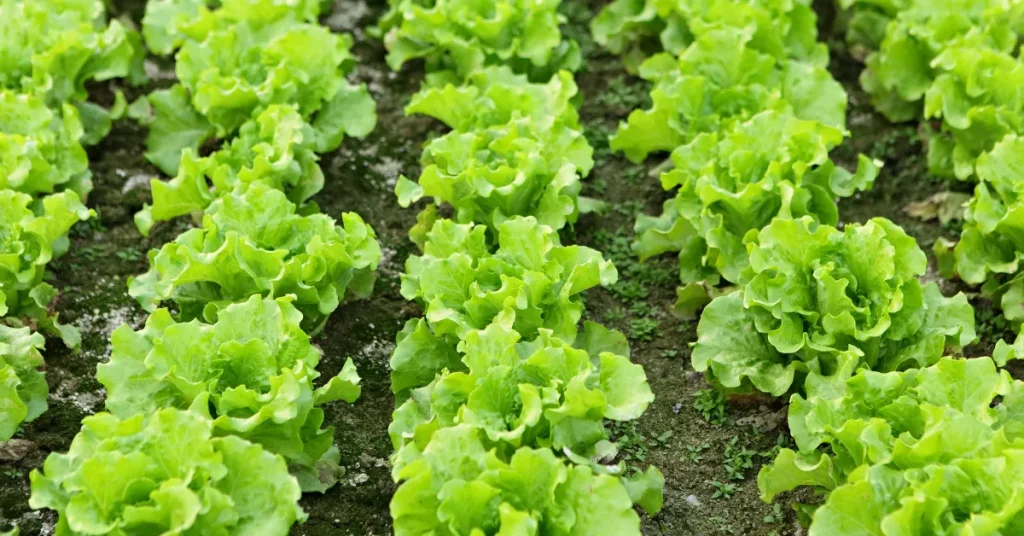Garden rows should typically be 18 to 36 inches wide. This range allows for efficient plant growth and maintenance.
Establishing the optimal width for garden rows can significantly impact the health and yield of your garden. Gardeners need to consider the type of plants, their growth patterns, and the tools they plan to use for maintaining the garden when determining the spacing.
A well-planned garden row layout contributes to good air circulation, ease of access, and effective weed control, making it a crucial aspect of garden planning.
Balancing space efficiency with plant health requires careful thought, but by adhering to this general guideline, gardeners can create a flourishing and productive space.
The width of your garden rows plays a pivotal role in the success of your planting endeavors, ensuring that your green space is not only beautiful but also bountiful.

Garden Row Basics
Planning your garden layout is exciting and important. Proper row spacing helps your garden thrive. It ensures plants get enough sunlight, water, and nutrients. Correct spacing also improves air circulation.
This can lower disease risk in your plants. In this guide, we’ll explore the essentials of garden row spacing for a bountiful harvest.
The Importance Of Row Spacing
Good row spacing leads to healthier plants. It makes weeding and harvesting easier. Plants spaced too closely compete for resources.
This can make them weak and less productive. Spacing rows correctly allows roots to spread. It ensures plants get what they need to grow strong.
Standard Row Widths For Different Crops
Different plants need different space. Here’s a quick guide to row widths:
| Crop Type | Row Width |
| Root Vegetables (Carrots, Beets) | 12-18 inches |
| Leafy Greens (Lettuce, Spinach) | 12-18 inches |
| Legumes (Beans, Peas) | 18-24 inches |
| Solanales (Tomatoes, Peppers) | 24-36 inches |
| Cucurbits (Cucumbers, Squash) | 36-48 inches |
Maximizing Yield With Optimal Spacing
Smart garden planning includes understanding how garden row widths impact your harvest. Creating the right space between rows lets plants flourish.
Whether you’re a budding gardener or an experienced grower, optimal spacing is key. It helps roots spread, leaves gather sunlight, and air circulate, preventing disease. Let’s dive into how to leverage spacing for the best yields.
The Relationship Between Spacing And Yield
Think of plant spacing as a balancing act. Too close and plants compete for resources. Too far apart and you waste space. This can make or break your garden’s productivity. Spacious rows mean more sun and air for each plant.
But, each variety has its own needs. For instance, leafy greens need less room than sprawling cucumbers. Consult seed packets or gardening guides for spacing recommendations catered to each plant.
- Root expansion: More room equals larger, healthier roots.
- Airflow: Proper spacing prevents moisture buildup and disease.
- Accessibility: Space for you to walk, weed, and harvest without harming plants.
Techniques For Efficient Plant Layout
Designing an efficient garden layout is more art than science. It combines spacing know-how with the nature of your crops. Here are techniques for a well-planned garden:
| Technique | Pros | Usage |
| Block Planting | Reduces pathways for more plant space | For plants with similar height and spread |
| Vertical Gardening | Saves space, promotes air circulation | Ideal for climbers like tomatoes |
| Succession Planting | Continuous harvest, maximizes space usage | Fast-growing crops like lettuce |
- Choose the right layout for your crops and space.
- Use garden markers to maintain the layout as plants grow.
- Adjust plans each season for crop rotation and soil health.
Remember, proper planning takes patience and practice. Pay attention to your garden’s unique traits. Keep notes on what works. Each season will teach you more about maximizing yield with optimal spacing.
Factors Influencing garden Row Width

Choosing the optimal width for garden rows can greatly impact the health and yield of your plants. The right spacing allows for efficient use of space, better access to sunlight, and ease of maintenance.
When planning your garden layout, several factors come into play that determines how wide your rows should be.
Soil Type And Nutrient Availability
The type of soil in your garden is a vital factor in deciding row width. Different soil types can affect root spread and thus, the space your plants need.
- Loamy soils allow for closer row spacing due to their good structure and nutrient distribution.
- Sandy soils, on the other hand, might require wider rows as nutrients tend to wash away more easily and plants need more space to find them.
- For clay-heavy soils, consider wider rows for better drainage and root development.
Watering Methods And Garden Size
The watering system you choose can also dictate how you space your garden rows. Different watering methods cover different areas and deliver water at different rates.
| Watering Method | Recommended Row Width |
| Drip Irrigation | Narrower rows |
| Soaker Hoses | Medium-width rows |
| Sprinklers | Wider rows |
Moreover, your garden’s overall size has an influence. Large gardens can accommodate wider rows without wasting space. Small garden spaces might require more compact row spacing to maximize the growing area.
Customizing Row Width For Your Garden
Finding the perfect row width for your garden presents a unique challenge. It often feels like solving a puzzle. Each piece represents a facet of your gardening dreams.
Understand that row width impacts everything from plant health to weeding efficiency. Read on to discover how to tailor garden row widths to suit your needs. You’ll learn to create a thriving garden space, tailored just for you.
Assessing Garden Conditions And Goals
Start by looking at your space. Consider the sun, soil, and slope. These factors shape your garden’s potential. Think about what you want to grow. Vegetables? Flowers? Both? Your goals dictate the path forward.
Remember, wider rows can lead to more weeds. Narrower rows might mean less room for roots to spread. Weigh these points to find a balance that serves your garden’s purpose.
Key considerations:
- Sun exposure: Track the sun’s path and note sunny spots.
- Soil quality: Soil tests reveal nutrient needs and texture.
- Slope: Check for areas with poor drainage or erosion.
- Garden layout: Sketch your space, imagining the flow.
Adjustments For Root Depth And Plant Height
Different plants need different spaces to flourish. It’s not just about the wiggle room above ground. Below the surface, roots seek nutrients and water.
Consider mature plant height as well. Tall plants create shade. This can affect neighboring crops. Use this knowledge to customize garden row width.
Below ground:
- Shallow roots: Leafy greens and herbs need less space.
- Deep roots: Root vegetables and tomatoes need more room.
Above ground:
- Tall plants: Allow extra space between rows for growth.
- Short plants: Place closer together to save space.
Smart spacing leads to happy plants. Happy plants yield better harvests. Keep these tips in mind and watch your garden thrive!
Tools And Tips For Row Planning

Planning your garden rows can greatly affect your garden’s productivity. The right tools and tips ensure optimal plant growth and ease of maintenance. Let’s explore how spacing guides and garden gadgets can assist.
Utilizing Spacing Guides And Charts
Spacing guides and charts are essential for garden planning. They help determine the ideal distance between rows and individual plants. Such guides take into account plant size and growth patterns.
- Seed packets and plant tags often provide spacing instructions.
- Use a garden planner app or online chart for personalized advice.
Charts outline the space needed for roots to expand and leaves to spread. They can be printed or accessed digitally for quick reference.
Innovative Garden Gadgets To Enhance Spacing
Modern gardening tools help achieve precise spacing with ease. Let’s look at some innovative options:
- Adjustable Row Markers: Drag along the soil to mark row distances.
- Spacing Rulers: Feature holes or markings at specific intervals.
- Dibbers with depth markings: Perfect for uniform seed placement.
These gadgets are often lightweight and durable. They simplify the process and save time.
Remember, proper spacing avoids overcrowding. It allows for adequate sunlight and air circulation. Your garden will thrive with these tools and tips.
FAQs About How Wide Should Garden Rows Be
How Far Apart Should Rows In A Garden Be?
Row spacing in a garden depends on the plant variety; typically, rows should be 18-36 inches apart to allow for growth and airflow.
How Wide Are Market Garden Rows?
Market garden rows typically range from 10 to 30 inches wide to accommodate various crops and ease of access.
How Wide Should Garden Aisles Be?
Garden aisles should typically be at least 18-24 inches wide to allow easy access for maintenance and harvesting. For wheelbarrow or equipment access, aim for 36 inches or more.
How Do You Layout A Garden Row?
Begin by selecting a sunny, level spot for your garden rows. Clear the area of weeds and debris and enrich the soil with compost. Mark the row paths with string or stakes, ensuring rows are evenly spaced. Dig or till the soil along these markers, then plant your seeds or seedlings.
Conclusion
Deciding the width of your garden rows is pivotal for crop success. Balance between plant needs and accessibility is key. Remember, optimal widths can vary, influenced by vegetable type and gardening tools. Embrace experimentation to find your garden’s sweet spot.
Happy gardening!
Resources:
1. https://extension.oregonstate.edu/ask-extension/featured/how-do-i-place-my-garden-rows-promote-best-growth
